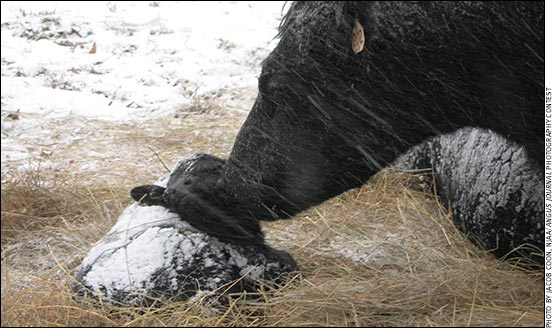HEALTH & NUTRITION...

Neonatal Care
Tips for managing compromised and weak calves at birth.
Fifty percent of beef calf death loss occurs within the first 24 hours of birth, and 70% of calf death loss occurs within three days after birth. Because of those statistics and the resulting impact on cow-calf income and profitability, Colorado State University professor Frank Garry emphasized the importance of monitoring and assisting newborn calves when needed after birth. Read more.
Cold Stress in Calves
Veterinarian offers tips for preventing, warming chilled calves.
Calves that are severely chilled at birth, without assistance to warm or dry them and to make sure they ingest colostrum in a timely manner, have poor survival rates. If a calf gets too cold before it suckles, it’s hard for the calf to get the teat in its mouth. The calf won’t obtain energy for keeping warm or antibodies to protect it against disease. Its ability to absorb antibodies from colostrum also diminishes as the calf becomes colder.
Producers need to be prepared for cold weather and try to minimize cold stress rather than just trying to deal with cold calves, advises Charles Stoltenow, North Dakota State University Extension veterinarian. Read more.
When to Assist
Tips for when and how to check a cow that is calving.
Most cows and heifers progress normally through the stages of labor. Sometimes, however, the calf does not start into the birth canal and the cow does not begin hard straining. Knowing when to check a cow is crucial — and you have to be watching her to know how long she’s been in early labor.
Mark Hilton, Purdue University veterinarian, says a good rule of thumb is to look for progress every hour.
“If we don’t see progress in an older cow, there’s a problem,” Hilton says, noting the head or a leg may be turned back, the calf may be coming backward or breech, or some other situation may be preventing it from coming into or progressing through the birth canal. “In heifers, lack of progress is usually due to the calf being too big.” Read more.
Start Them Off Right
Veterinarin Kevin Hill shares tips for animal health.
Healthy cows raise healthy calves, a key driver in profitability for ranchers. Kevin Hill, veterinarian for Merck Animal Health, said he realizes there are things at the ranch with bigger dollar signs behind them than health, but unhealthy animals can put ranchers out of business.
As a form of insurance to help outweigh the risk health represents, Hill suggested having clear vaccine protocols and plans. The overall goal? Effective immunization.
Read more.

Rick Rasby
Ridin’ Herd
Managing first-calf beef females after calving
Calving season is upon us. You’ve spent a lot of time selecting, managing and designing a breeding program for the females that are calving for the first time. If the replacements were selected from your herd, these heifers haven’t generated any income for almost two and a half years when they wean their first calf. Skimping on the groceries for first-calf females after calving is not a place to save on feed costs. Read more.
Mineral Boost Optimizes Reproductive Performance
Providing highly fortified vitamin, mineral supplement to beef cows two months prior to calving and through breeding improves conception rates, reproductive health.
For cow-calf producers, there are certain times that significantly impact the operation’s profitability. Failure to manage the nutrition of the cow herd during these critical times can hurt productivity in ways that producers often do not think about. Research has shown that supplementing the herd with important vitamins, minerals and proteins before calving and through breeding improves a cow’s body condition and conception rates and, in turn, overall calf health and survival rates, making this a critical time for supplementation.
In a beef herd, profitability is determined by several factors, including the total weight of calves sold, cost of maintaining the cow herd, percentage of cows bred that wean a calf, and the price received for calves. The most critical times to influence these factors are the two months prior to calving and through breeding. Read more.
Preventing Predation on Livestock
A K-State wildlife specialist discusses nonlethal and lethal methods for producers to employ.
Ask livestock producers in Kansas to name the most threatening predator to their operation, and most, if not all, will have the same answer: coyotes. In Kansas, this member of the canine family can be trapped year-round for fur or sport, or to control livestock predation.
Kansas State University (K-State) wildlife management expert Charlie Lee said that beyond Kansas, coyotes and other predators such as mountain lions, bobcats and even domestic dogs have been and continue to be a problem for livestock producers nationwide.
In a 2011 National Agricultural Statistics Service (NASS) report, cattle and calf losses from animal predators totaled nearly 220,000 head the previous year and resulted in a loss of $98.5 million. In Kansas, producers reported roughly 800 cows and 3,900 calves lost to predation, which equaled a $2.2 million loss. Read more.
Cattle Diseases: Common Conditions/Terms
Click here for a list of common conditions and terms related to beef cattle diseases, such as anaplasmosis, brucellosis, BVD, E. coli, IBR and others.
[Click here to go to the top of the page.]






